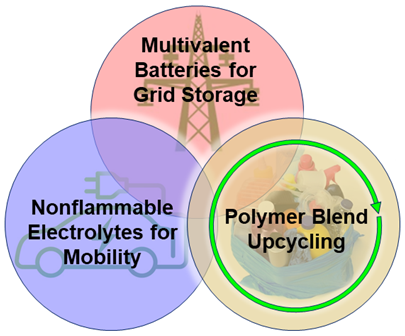2024 AIChE Annual Meeting
(4nh) Polymer and Interfacial Engineering for Energy and Sustainability
Author
Independent (future):
My research vision is based on the Sustainable Development Goals (SDGs) set forth by the United Nations: #7 (Clean Energy) and #12 (Responsible Consumption and Production). Rechargeable batteries are becoming increasingly important as our world transitions to a more sustainable energy landscape. Lithium–batteries are unmatched in performance, but the scarce and narrow supply–chain of lithium has prompted the quest for alternative candidates. On the other hand, dealing with plastic waste sustainably also remains a major global challenge. My research program will focus on these two problems. I propose to pursue 3 research innovations: 1) Develop New Polymer Materials for Multivalent Grid Energy Storage; 2) Engineer Nonflammable Green Composite Electrolytes for Electric Mobility Applications, and 3) Establish Fundamental Insight into the Photothermal Catalytic Upcycling of Polymer Waste using Operando Spectroscopy. Collectively, these aims are tied to SDG #13 (Climate Action), wherein I aspire to make a positive impact.
Postdoctoral (current): Structure–Property Relationships in Confined Polymer Electrolytes
Advisor: Prof. Russell J. Composto, Department of Materials Science and Engineering, University of Pennsylvania, Philadelphia, PA
As a Postdoctoral Researcher in the Composto Group, I have created protocols to fabricate high–loading 3D polymer electrolyte composites for sodium (Na) batteries. This project is an NSF–funded, cross–cutting collaboration across the US. I am actively involved in materials characterization and prototyping with collaborators from the Stanford Linear Accelerator (SLAC), Drexel University, and internally at Penn. Additionally, I investigate structure–property relationships in polymer electrolytes and gels containing 2D materials like boron nitride, guided by first–principles calculations performed by collaborators at Harvard University. I am also responsible for organizing and leading the monthly Penn–Drexel subgroup meeting for this project.
Doctoral (past): Structure and Morphology of Nanoparticle–Containing Monomer Mixtures Under Patterned Irradiation
Advisor: Prof. Ian D. Hosein, Department of Biomedical and Chemical Engineering, Syracuse University, Syracuse, NY
As doctoral student in the Hosein Group, I investigated nanoparticle dynamics in photochemically–reacting media using in–situ Raman spectroscopy. I developed a custom reaction setup and reported the direct observation of light–intensity–dependent nanoparticle phase–separation across large length scales (ca. 500 µm) in the z–direction: low light intensity prevents phase–separation whereas high light–intensity arrests it. I extended this work to develop superhydrophobic polymer composites with excellent processability in a single–step. This work was featured on ACS C&EN. I also synthesized and characterized new polymers and ionic liquids for multivalent batteries.
Teaching
I look forward to teaching core undergraduate courses in Chemical Engineering and Materials Science. I have instructed for the Engineering Materials, Processing, and Properties and Statistical Methods course at Syracuse University, and am excited about developing electives in soft matter and electrochemistry at the undergraduate and graduate levels.
Diversity, Equity, and Inclusion
My experiences have taught me that diversity is truly enriching. I am committed to enhancing diversity, equity, and inclusion (DEI) in science and engineering. I will design my teaching methodology to be adaptable for inclusivity, and my research program to create meaningful outreach via community–based dissemination of science such as at local museums and high–schools. At Penn, I have served as the group lead for the flagship Philly Materials Day in 2023 which attracts thousands of visitors. I will leverage departmental and institutional resources to attract students from underrepresented groups to my research program. With these efforts I hope to build a safe, welcoming, and intellectually stimulating research environment for my students.
Selected Publications
*Indicates undergraduate mentee; 1Indicates equal contribution
1.) S. Pathreeker, *C. A. Snyder, G. V. Papamokos, and R. J. Composto. ‘Hexagonal Boron Nitride Modulates Crystallinity and Charge Mobility in Poly(ethylene oxide)–NaNO3 Electrolytes’; The Journal of Physical Chemistry C, 128, no. 1 (2023), pp. 38-49. https://doi.org/10.1021/acs.jpcc.3c06455.
2.) S. Pathreeker and I. D. Hosein. ‘Vinylimidazole–based Polymer Electrolytes with Superior Conductivity and Promising Electrochemical Performance for Calcium Batteries’; ACS Applied Polymer Materials, 4, no. 10 (2022), pp. 6803–6811. https://doi.org/10.1021/acsapm.2c01140.
3.) S. Pathreeker and I. D. Hosein. ‘Superhydrophobic Surfaces Developed via Photopolymerization’; ACS Applied Polymer Materials, 3, no. 9 (2021), pp. 4661–4672. [Front Cover]. https://doi.org/10.1021/acsapm.1c00744.
4.) S. Pathreeker, F.–H. Chen, S. Biria, and I. D. Hosein. ‘Observation of Intensity Dependent Phase–Separation in Photoreactive Monomer–Nanoparticle Formulations under Non–Uniform Visible Light Irradiation’; Soft Matter 16, no. 31 (2020), pp. 7256–7269. [Front Cover]. https://doi.org/10.1039/D0SM00922A.
5.) *E. C. Fluker1, S. Pathreeker1 and I. D. Hosein. ‘Polyvinylidene Fluoride–Based Gel Polymer Electrolytes for Calcium Ion Conduction: A Study of the Influence of Salt Concentration and Drying Temperature on Coordination Environment and Ionic Conductivity’; The Journal of Physical Chemistry C, 127, no. 33 (2023), pp. 16579–16587. https://doi.org/10.1021/acs.jpcc.3c02342.
6.) *N. Wellington1, S. Pathreeker1, and I. D. Hosein. ‘Light–Induced Self–Writing of Polymer Composites: A Novel Approach to Develop Core–Shell–Type Structures’; Composites Communications (2022), pp. 101058. https://doi.org/10.1016/j.coco.2022.101058.
7.) S. Biria, S. Pathreeker, F. S. Genier, H. Li, and I. D. Hosein. ‘Plating and Stripping Calcium at Room Temperature in an Ionic-Liquid Electrolyte’; ACS Applied Energy Materials, 3, no. 3 (2020), pp. 2310–2314. https://doi.org/10.1021/acsaem.9b02529.
